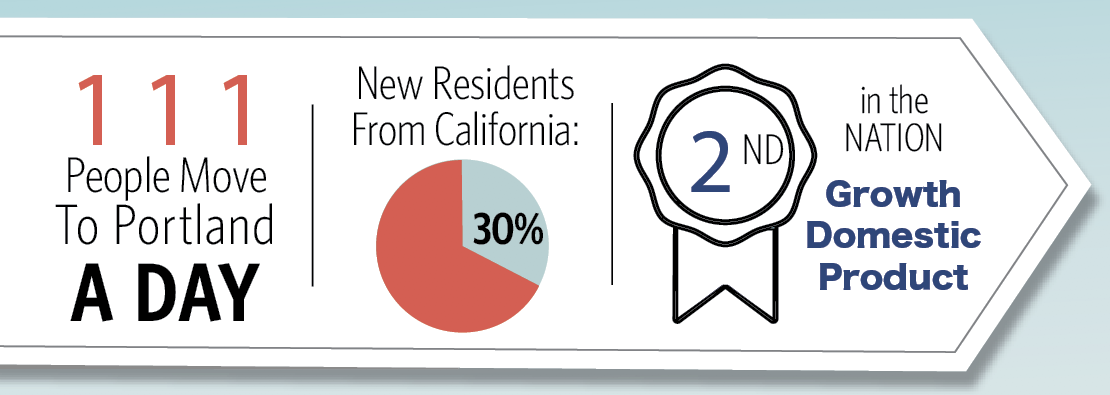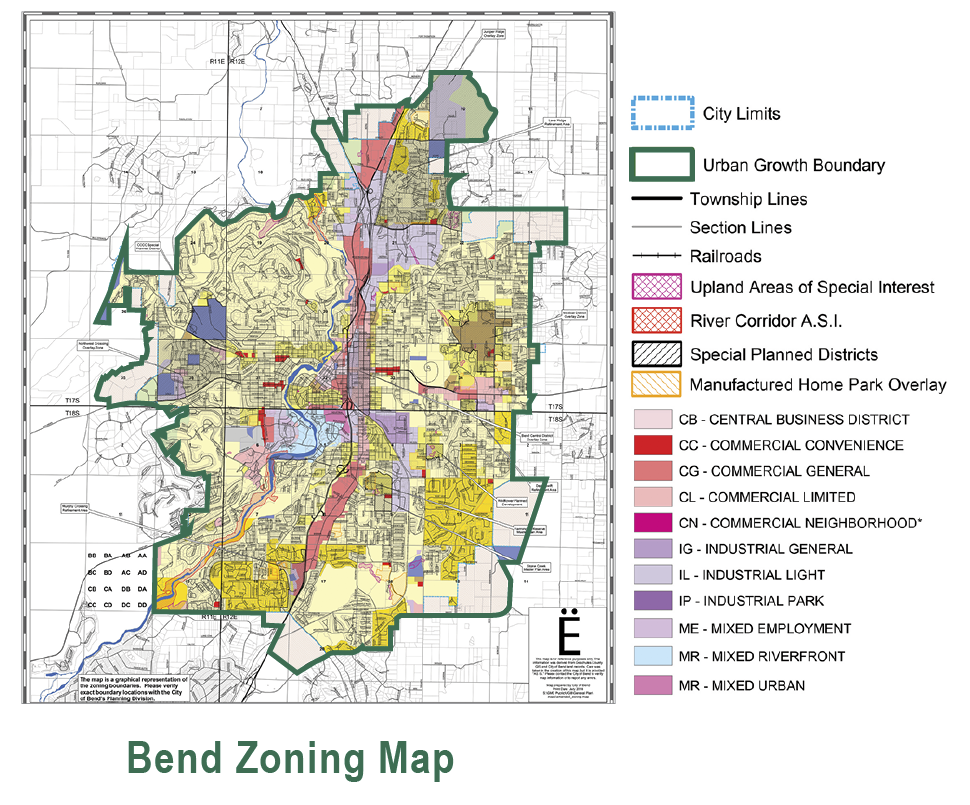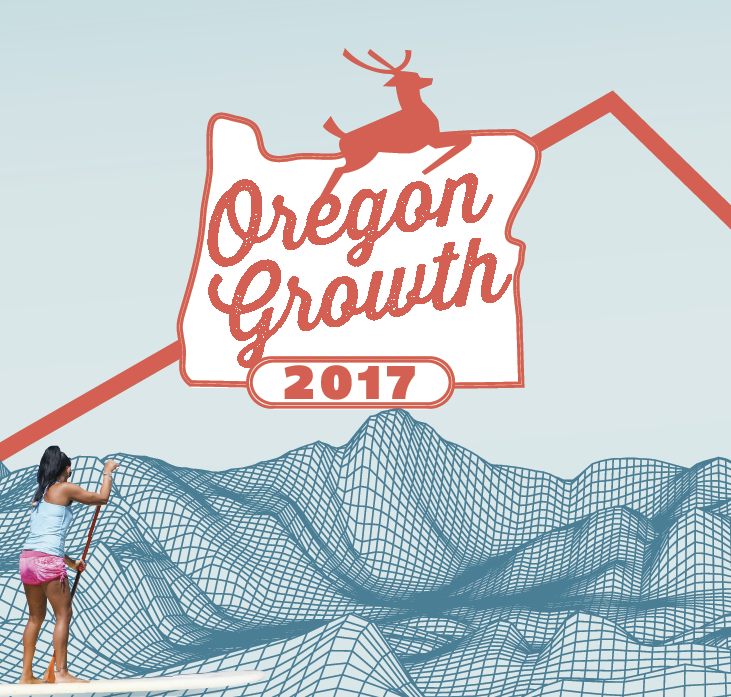How Oregon is preparing for population and economic growth
written by Tricia Louvar
Blame Oregon for being gorgeous. She’s a natural beauty who doesn’t have a bad angle. Humans want to scale Oregon’s peaks. Get inside the caves. Fish the fresh waters. Bike sinuous trails. Camp and imbibe. Oregon has become the pageant winner. Such a reputation has also brought a high-maintenance edge.
Oregon ranked as the top destination in the country for transplants from 2013 to 2015, according to United Van Lines. Jobs and nature tend to lure and serenade. With growth management comes affordability frustrations and density concerns. The state’s citizen workgroups and lawmakers have jostled and negotiated the boundaries between nature and culture, trying to keep the feverish encroachment in check.

Oregon vs. California
California haters sprinkle the Beaver State. Oregonians-who-dislike-Californians blame them for jacking up housing prices because they sold high there and bought low here.
“Whether people from California or Kansas are moving here, they are adding to the local housing demand,” said Joshua Lehner, senior economist at Oregon Office of Economic Analysis. “This has been happening forever in Oregon since Lewis and Clark or even the Bering Land Bridge.”
Regarding adult migration, only one of three Oregonians was born in Oregon. Thirty percent of the new residents to Oregon are moving from California. Lehner noted that most Californians go to Portland, and a disproportion chooses the coast, Southern Oregon (e.g., Ashland and Medford) and Bend. “Focusing on new residents is one facet of the affordability discussion,” Lehner said. “Oregon needs to add supply, however, to match the demand.”
Analysts from WalletHub, an online credit reporting firm, named Oregon in 2017 as second in the nation with the highest growth domestic product. The accolades continue stacking: Bend-Redmond area ranked eighth in the nation for fastest growing metro area; Portland ranked 23 in largest metro areas in the country, even exceeding Pittsburgh, according to Metro, which is greater Portland’s regional government agency.
The Oregon Population Boom
In the mid-’90s, net migration soared to more than 60,000 people arriving thanks to economic expansion and jobs. On average over the past twenty years, about 28,000 people migrate to Oregon a year. Urban areas comprise most of that population gain, with around 111 people moving to Portland each day, per the U.S. Census Bureau in 2014-15. With 83 percent of Oregonians living in metro areas, transportation and roadways have become larger issues. Once peaceful four-lane parkways, connecting the north and south, have turned into gridlock flatulence.
Three hours south and over the mountains sits Deschutes County, which remains the hotbed of population expansion, with Bend as its county seat. The county’s population grew 3.6 percent over the prior year, reaching 181,307 as of 2016. Central Oregon’s denizen of outdoor enthusiasts—Bend—has become the microcosm of growth management issues for mid-size cities. Local bumper stickers read “Bend Sucks! Don’t Move Here.” The reverse psychology isn’t working so well.
Bend is the Epicenter for Expansion

Many Bendites want to keep their small-town small, keep Mount Bachelor runs unpopulated, the local coffee roasters thriving and parking spots open near trailheads. These are the “pack it in, pack it out, leave no trace behind” people. Such a culture is becoming harder to maintain with Bend experiencing full-throttle economic growth at a 6 percent pace.
“Every city wants to have a strong local economy, high quality of life and housing affordability for its residents. Unfortunately, these three dimensions represent the Housing Trilemma,” Lehner wrote. “A city can achieve success on two but not all three at the same time. Underlying all of these tradeoffs are local policies as well.”
The housing trilemma is a nationwide issue, not just an Oregon problem. The Pacific Northwest metro areas exhibit the quality of life and economic strength, Lehner noted, but lack affordability. (Note: His analysis showed that Des Moines, Omaha and Oklahoma City encompass the trifecta. So, move east then?)
Zillow revealed Oregon home values shot up 11.4 percent over the past year. Portland has the highest price per square foot at $323. If you want to buy a house anywhere in Oregon, the median price currently listed is $349,000.
In Bend, a westside 0.3-acre lot with a view costs $175,000—a bargain if you set up a tent and know how to use a compost toilet. Winters will be cold. The median home price in Bend is $384,600. Perhaps a steady uptick to a housing bubble?
Deschutes County’s population jumped 15 percent over the past six years, which is tremendous in comparison to Multnomah County’s population surge at 8.8 percent over the same time frame. In a year, the Bend-Redmond metropolitan statistical area rose seven spots to first place by the Milken Institute as the 2016 Best-Performing Small City in the U.S. Bend’s health care system, diverse economic base and high-tech industry were attributable to moving it to the coveted top spot.
Since 2010, one of five residents in Bend is new to the city. The “adventure town” label has drawn lifestyle businesses to Bend, making it one of the fastest growing employment sectors (behind construction). Ruffwear, HyrdoFlask, Metolius Climbing, Cairn, SnoPlanks, Backstrap, Soleprint, Sudara and Entre-Prises are a few of the town’s lifestyle brands.
There’s something in the snowmelt, though. Dreamers consult Bend Outdoor Worx, a startup incubator for outdoor industry entrepreneurs, and Oregon State University-Cascades (in Bend) is launching an outdoor product development degree. Where else can you wear hiking sandals to a business meeting and still be respected? Bend makes standup paddleboard meetings look good.
You know there are growth management concerns when one section of Bend—the Central Westside—has a 52-page executive summary on its mixed-use urban core. The proposal wants to accommodate modest density, transportation, travel time and land-use changes.
Development concerns go way back in Oregon. In the 1970s Governor Thomas McCall went around Oregon, publicly rebuking people who carved and populated the state’s open land without much forethought. He urged the Legislature to pass Senate Bill (SB) 100, which denounced “sagebrush subdivisions, coastal condomania, and the ravenous rampages of suburbia.”
Oregon lawmakers passed the land-use planning law in 1973. With SB 100 came the creation of the Land Conservation and Development Commission (LCDC). It required each city and county in Oregon to create and abide by the regional land-use planning system. (Many may think of SB 100 as the first land-use law. Portland, however, became the first Oregon city in 1918 to pass its self-regulating land-use ordinances.)
An urban growth boundary is a state-specific mandate that tries to control urban sprawl’s perimeter of a city. The UGB protects farmland and preserves rural attributes. In theory, a UGB has within it a twenty-year land supply for development. It has considered density, economic development, transportation and housing opportunities. The map specifies opportunity areas and expansion areas inside the territory.
The implementation of UGB has no shortage of critics, whether it hurts or helps land-use regulations. Some view the UGB as a mechanism for creating unaffordable housing conditions. “Oregon has affordability challenges, but it’s a phenomenon in the growing U.S.,” Lehner said. “Bend just happens to be a little worse than other areas, because it doesn’t have a lot of buildable inventory.”
In April 2009, the City of Bend and the County agreed to amend the UGB. Over the course of eight years, seventy public hearings, sixty volunteers and three technical advisory committees culminated to finalize the UGB that the LCDC “acknowledged” (code for approved or passed). Bend now has 2,380 more acres for housing and business development as of December 2016. Help is on the way—it’s just that building takes time.
Bend’s UGB map offers in detail the opportunity and expansion areas. The map showcases how Bend will maximize land use inside the city before expanding the footprint. Development of an opportunity area such as the 22-acre KorPine site, the former particleboard milling plant in the Old Mill District, will offer an urban district environment of high-rise apartment buildings and a commercial center. The development near Franklin Avenue allows for a mix-use zone of residential space on the top floors and businesses on the bottom floors of new buildings.
Development ensures that housing demands and employment are at the core of the expansion. The collaborative task force, Bend 2030, engaged one in seven residents about the vision of their city. “There is still some NIMBY here, but hearts and minds change with education, and we can work on it,” said Erin Foote Morgan, executive director of Bend 2030.
Foote Morgan, 37, said finding solutions to the middle-market housing dilemma occupies much of Bend 2030. The middle-market suffers the most. For example, in 2015 there were 2,778 homes available for a household making $150,000 or more, whereas for those earning between $49,999 and $99,999 there was a deficit of 798 available homes. The rental vacancy rate has been less than 2 percent since 2013.
The lopsided housing availability puts pressure on business owners to pay and sustain its employees. If you can’t live here, you move farther out and commute longer. You can’t save for a home if your salary is a pittance and your rent is high. The cycle won’t break but people will. Solutions are in order.
Bend 2030 formed a task force called the Bend Collaborative Housing Workgroup, a steering committee of thirty professional residents who want to find policy solutions. It worked extensively with ECONorthwest, a Portland-based economic consultancy, which completed a microeconomics study on the housing situation and economic development.
The Landscape Report found home ownership for the middle-market sector is out of reach. “With a lack of inventory and the slow building timeline these equate a bad equilibrium for selling and buying,” Lehner said. “Therein lies one challenge of the housing crunch.”
Bend Collaborative Workgroup took the Landscape Report and buckled down. It worked 500 hours over eight months to whittle from fifty strategies to twelve. These twelve will be open to public feedback. The workgroup favors recalculating congestion standards to include pedestrians and bicyclists (not just car counts). It also proposes reworking system development charges (SDCs), a financing tool used by cities, to offer developers a hierarchical fee structure to incentivize building smaller units and increasing housing supply. Parking requirements and vertical housing tax exemption are on the docket for implementation, too.
Bend is at its worst point regarding housing availability, but things are going to get better. The workgroups keep looking at long-range plans to maintain supply and advocate for adequate services for its citizens. Developers will offer a new mix of middle-market housing types—bungalow complex, courtyard apartment, triplex and fourplex, duplex, townhomes, multiplex and the live-work buildings. These may be shoehorned between detached single-family homes and mid-rise residential buildings. Diverse housing allows for higher-density living spaces to alleviate traffic congestion. With an urban core comes more walkable, connected passages.
Bend’s engaged residents and its workgroups are taking a leadership role in shaping their city’s future. “People don’t have to be angry [about change],” Foote Morgan said. “They need to put their energy into the solutions that maintain the character of the small-town environment—the reason why most of us moved here.”








